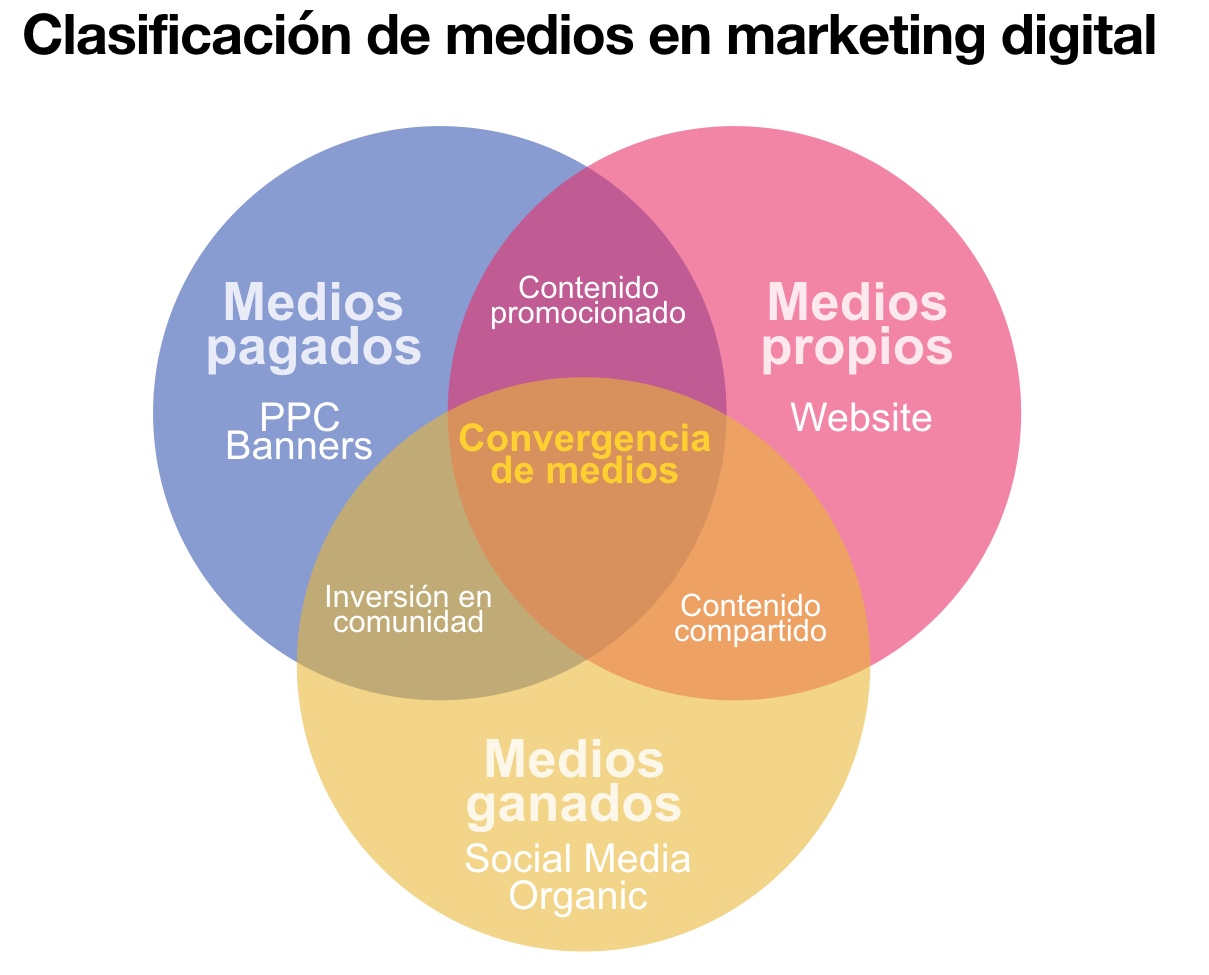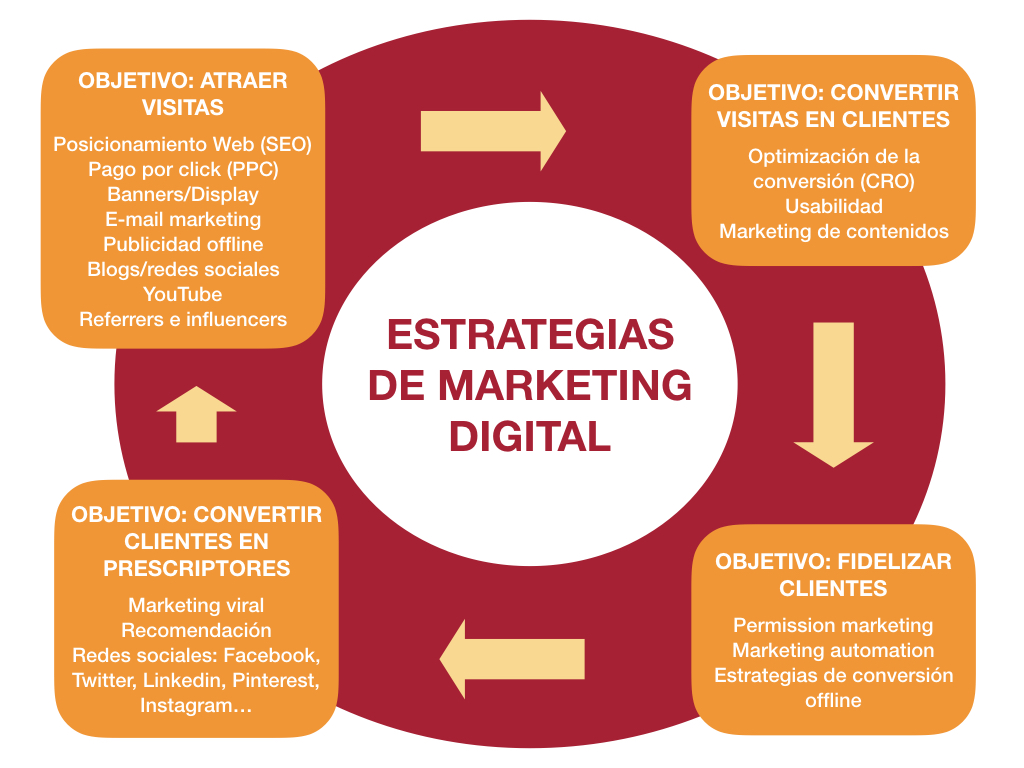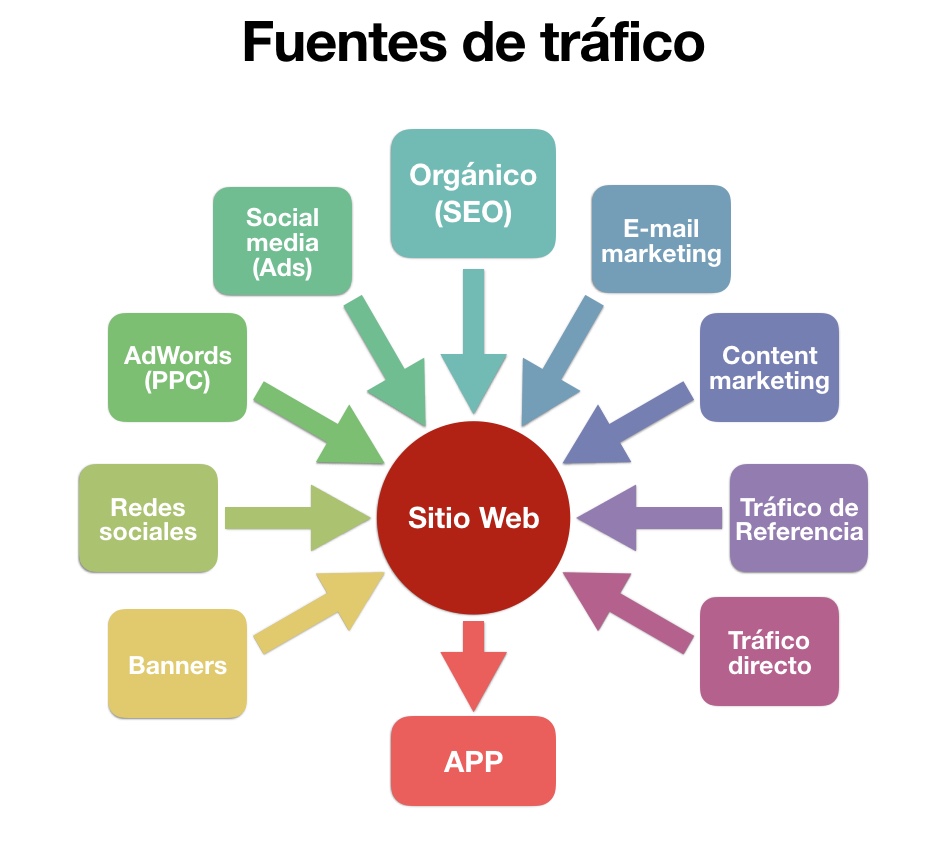Written by Fernando Maciá
Index
- What is digital marketing?
- Structure for a digital marketing plan
- Definition of objectives: the starting point of any marketing plan
- Definition of target audiences: knowing our target
- Definition of tactical objectives
- A digital marketing strategy for each objective
- Allocating resources and deadlines to the online marketing plan
- How to measure the success of our online marketing plan
- Key Performance Indicators
- Measuring Web performance
- Digital marketing bibliography and resources
What is digital marketing?
Digital marketing, online marketing, e-marketing or Internet marketing refers to the promotion of products or services on the Internet. In a more concrete way, we would be calling under these concepts the set of marketing strategies that we can use to attract and retain customers to a website.

A business presence on the Internet today requires a continuous dedication of financial resources and time by at least a few people in the company or an external collaborator, and it is simply not realistic to expect that a website will register traffic, contacts or sales if, among other things, its content is not renewed frequently. The content is analyzed, user behavior is analyzed and aspects such as positioning, design and usability are constantly improved.
Digital marketing uses various means to attract qualified visitors who can become customers: online advertising (banners, display, etc.), SEO, email marketing, community building on social media sites, social media campaigns, etc. Thus, a distinction is usually made between owned media (for example, our website or our app), earned media (the references that customers and followers can make about our product or brand in their social networks) and paid media (such as banner campaigns or SEM).
In terms of the different types of strategy, we usually speak of inbound and outbound strategies.
The strategies of inbound marketing refer to those that are aligned with the user’s interests and, therefore, are not perceived as intrusive. Hence, these strategies are also often referred to as permission marketing. Some of the platforms used for inbound marketing are Hubspot, Marketo, Sales Force or Connectif. The media commonly associated with inbound tactics are owned and earned media.
Main inbound marketing strategies:
- Natural positioning
- PPC or SEM
- Permission/e-mail marketing
- Content marketing: publications, reports, white papers, white papers, e-books…
- Social networks
- Viral marketing
- Training, courses, guides…
Outbound marketing strategies refer to those that make use of advertising. Because this advertising is shown to the audience while they are browsing the Web or viewing content, it is also often referred to as interruption marketing, as it is often perceived as intrusive by the target audience. Media associated with outbound tactics are usually paid media.
Main outbound marketing strategies:
- Display advertising campaigns
- Interstitials
- Remarketing
- Retargeting
- Spots in video content
- Social media ad campaigns
- Spam
Structure for a digital marketing plan
A results-oriented online or digital marketing plan will typically include at least the following items:
- Identify the profiles of the potential audience or target, often based on the analysis of a buyer persona.
- Establish objectives for each of these profiles.
- Establish a strategy to achieve these objectives.
- Decide on the specific tactics with which we will implement the strategy.
- Allocate resources and deadlines.
- Define how we will measure the success or performance of our plan: sales, conversions, leads…
In this sense, the website as well as the corporate profiles in the different social networks must be aligned with the marketing-mix of the company and the investment of time, money and resources required for their creation and maintenance must result in the creation of value for the client and the production of benefits for the company.
Definition of objectives: the starting point of any marketing plan
Regardless of the goals it pursues, a website will always involve a considerable investment of time and resources that will only be justified to the extent that it achieves certain goals.
Definition of strategic objectives
The strategic objectives of a company’s website must be in line with the general strategy of the company, set by its General Management. Defining with great specificity the profile of the target audience to which your website is addressed will help you to define the role of your site within the marketing mix of your company, what objectives you expect it to fulfill: perhaps it will act as an alternative marketing channel; as a showcase through which to attract new customers; a way to probe the potential of new markets; as a channel of contact with your franchisees or distributors…
Based on strategic planning, each department will establish the objectives for its own area. To identify the profiles of the different target audiences of the website or target, it is advisable to create a multidepartmental team that is able to provide a global and integrated perspective on the goals to be set for the company’s website.
Definition of target audiences: knowing our target
In the definition of the Web’s target audiences, we can clearly see how important it is to have representatives from each department. It is clear that Commercial will immediately refer to customers. And Purchasing will top its list with Suppliers. The General Management may also wish to have a section for informing the Partners or Shareholders. Marketing will want to attract new potential customers, but you may also want to contact importers, exporters, partners or franchisees…
By segmenting the target audience in this way, we can define a list of different types of target audiences that will each visit the company’s website for different reasons:
- Potential customers
- Current customers
- Prescribers
- Partners
- Partners
- Shareholders
- Representatives
- Opinion leaders
- Importers
- Exporters
- Franchisees
- Distributors
- Installers
- After-sales services
- Media and communications
- Candidates, etc.
It is important to consider all conceivable target audiences in order to then establish a hierarchy of priorities according to their greater or lesser contribution to the creation of value for the company. Based on these priorities, we can divide the entire project of creating the new website into phases to be undertaken progressively in the order decided.
To know the most likely behavior of our potential customer, it is very useful to apply methodologies such as the “Customer Journey” through which we analyze the different phases through which a user goes from the first time he is aware of a need until he finally executes the action to satisfy it. You can see here a presentation on Customer Journey showing this target analysis model.
Once each target audience profile has been defined, it will be easier to identify what content or functionalities on our website justify their visit and meet their expectations.
If the website is already published and we have to decide how to promote it, the definition of the target audience will be equally important as it will influence the choice of strategies for traffic acquisition (SEO or PPC, social networks or offline advertising), conversion, loyalty (e-mail marketing or content syndication), etc.
Definition of tactical objectives
The next point to be decided by the interdepartmental working group is: for each target audience defined in the previous list, decide which objectives the Web should meet. These objectives will be tactical and must be aligned with the strategic objectives set for the site. Again, having people from different departments will provide us with a much broader vision that will favor the creation of synergies. Let’s see:
Possible targets for the target audience “Potential customers”:
- Increase the rate of new customer acquisition.
- Reduce the cost of acquiring new customers.
- Increase the geographical scope of the clientele: develop sales in new markets or explore their potential.
- Demonstrate the product to new customers.
- Increase the branding of our brand.
Possible targets for the target audience “Current customers”:
- Increase purchase frequency.
- Encourage cross-selling.
- Build customer loyalty (extend their life cycle).
- Convert customers into prescribers.
- Propose an alternative sales channel.
- Etc.
And so, successively, we will define the objectives we wish to achieve for each target and, once again, we will prioritize them. Some of these objectives may be proposed from the moment the web is launched and others may be undertaken in successive phases. But what is certain is that, with this type of planning, the architecture, content and promotion of the website will respond to the expectations, needs, searches and usage scenarios that your customers are most likely to come up with in the future.

A digital marketing strategy for each objective
Once you have defined the goals you want to achieve with your online presence, it’s time to decide which strategies will help you achieve them. Online marketing comprises different types of strategies to attract visitors and convert them into loyal customers. Although we have already advanced some clues, we can now see that, depending on the objective that each strategy fulfills in our relationship with the customer, we could group them into four types:
- Traffic attraction strategies.
- Strategies for converting visitors into customers.
- Customer loyalty strategies.
- Strategies to achieve evangelists: customers who become prescribers.
Let’s now take a very brief look at the online marketing strategies that can be used for each of these four fundamental objectives.

The first objective of a website will be to attract quality traffic to it. There are several ways to achieve this purpose:
- Offline advertising: obviously, we must include the URL address in all offline communication: stationery, corporate identity material, vehicle signage, advertising, direct marketing, etc. You can also carry out specific actions to communicate the opening of the new portal to your suppliers, distributors, customers, partners, investors, etc.
- Natural Search Engine Optimization (SEO): SEO focuses on optimizing a website with the objective of getting search engines to position your pages among the first results for searches that your customers might make, mainly Google. For most websites, it is one of the main sources of quality traffic. In addition, it is one of the so-called owned media, so the cost of acquisition (CPA) is usually lower than with other online marketing strategies.
- Paid links (PPC): Paid links, PPC or SEM is the logical complement to an SEO strategy. In order to be present in very competitive searches where it does not appear in the first positions, as well as to have traffic coming from search engines from the first moment, we count on Google AdWords. A formula that allows you to size your campaign according to your own investment capacity, as well as to segment it very specifically according to certain geographic criteria or to increase the visibility of your website on search engine results pages during peak periods, if your products or services have a seasonal profile.
- Online or display advertising: the launch of a new portal can be reason enough for a banner campaign, interstitials or other rich media ad formats on portals whose user profile is similar to that of your potential customer. Banners require a relatively large investment, so it is mainly larger companies that invest in this strategy. It is also used for retargeting strategies, that is, to show advertising to users who have previously shown some interest in our website.
Both Google AdWords (PPC) and display advertising would fall under the so-called “paid media“. It is obvious that the less organic traffic we manage to attract, the more we will have to invest in these media that have a higher cost of acquisition (CPA).
Strategies for converting traffic into customers: CRO, usability and design
Assuming that with any of the four strategies in the previous point you achieve your traffic generation objectives, the next goal is to monetize that traffic by converting visits into customers.
Online conversion
In the event that the conversion occurs online – as in the case of an e-commerce – it will be easy to measure that conversion as a percentage of sales made over the total number of registered visitors.
Offline conversion
In other cases, the conversion will occur offline and will require more control by the company to be able to measure it (for example, if the conversion consists of getting the potential customer to call on the phone or the sale is completed in a physical store).
Conversion Rate Optimization (CRO)
In any case, it will be time to assess the usability of the website and improve its conversion rate (CRO). If you have already improved the way visitors arrive at your portal, it is time to see if your portal is in the best condition to adequately meet the objectives you have set for it. Among many other things, you should assess the following points:
- Your website is an e-commerce: from the buyer persona’s point of view, is it specified from the beginning from which countries it is possible to buy on it? what are the applicable shipping costs, customs, etc.? what are the means of payment that can be used? how does the website ensure user satisfaction? which certificates ensure data and transaction security?
- Is your website a prescription site or an online catalog: is there a FAQ section, a glossary explaining the meaning of technical terms? Do you provide accurate information about your distributors or the points of sale where users can purchase your products?
- Your goal is to be contacted by phone: is the company’s phone number hidden on the contact page, within the corporate section three clicks away from the home page or is there a permanent phone information box in any section of your website?
- If you provide after-sales or customer service information on your website: have you foreseen any means of collecting feedback on this service? How do you rate the degree of satisfaction obtained?
- Consider the different levels of commitment a visitor is willing to make: some people will call you, some will prefer you to call them, some will prefer to leave a simple contact e-mail or some will be happy to fill in a whole form with personal information… Does your website provide for different contact alternatives?
- In case of a product search with a negative result: does your portal offer other similar products or services that could be considered as an alternative by your users?
- Is your website likely to be consulted by mobile users: do you have a version adapted for mobile terminals? Is your website compatible for navigation from smartphones and tablets?
Customer loyalty or permission marketing strategies
Once you start getting customers, your main concern should be to build customer loyalty: getting them to come back again and again, to keep buying, to participate in a loyalty program or to subscribe to information that interests them. In any case, may that first bond achieved not be broken. One of the most useful tools for building customer loyalty through the Internet is permission marketing, or permission e-mail marketing. It is one of the ways in which direct marketing from the real world jumps to the virtuality of the Web. In short, when a customer subscribes to your newsletter, he will already know what he bought, what he was interested in, where the visit came from, how he found you, what language he speaks… You can personalize your message much more and individually tailor your offer to them. It will be much easier to get a satisfied customer to buy from you again than to get a new customer.
If natural search engine optimization, PPC or banners are the ways to keep increasing the number of new visitors, permission marketing or e-mail marketing is the way to increase the loyalty of existing customers and increase their frequency and volume of purchases.
Social recommendation strategies: converting loyal customers into referrers
Finally, once you have a large base of satisfied customers, why not use them as your portal’s best advocates? After all, if they buy time and time again, wouldn’t it be easy for them to recommend you to their network? This is something that, if your service is sufficiently attractive, could occur naturally. But it is always better to enable means of “incentivizing” your loyal customers to recommend you to their friends and family. We call this type of media “earned media” since it is others who collaborate to increase and spread our online visibility.
Many companies have already joined this trend by creating communities on social networks, a fabric within which users acquire a sense of belonging to this or that trend, technology or brand. More experienced users can act as opinion leaders and even as first assistants for novice users.
The cost of this type of prescription is low and the impact it can have on traffic and new customer acquisition, when properly managed, can be very large.
In general, we find marketing agencies specialized in a few of these online strategies as well as some large agencies that offer all types of strategies: inbound, outbound, media buying, content, copywriting, etc.
Allocating resources and deadlines to the online marketing plan
Nowadays, a website is like any other business: every day we have to open the shutters, take calls, produce new content, study what our customers want, figure out new ways to respond to changing demand and meet their expectations. It will also be necessary to foresee the necessary resources not only for technical maintenance, hosting, etc. but also for traffic dynamization: natural positioning in search engines, creation of new contents, payment of sponsored links, e-mailing campaigns, banners, etc. as well as the logistics that may arise from online sales, payments, etc.
Web 2.0with its vocation for greater levels of participation by all users, opens up new opportunities for visibility on the Web, but it also requires a greater effort to focus and channel these efforts in favor of the company in an environment where the voice of any user can have an enormous impact, for better or worse.
Allocating resources also involves describing ways to calculate the Return on Investment (ROI) of the resources invested. It will be time to quantify the objectives set, define the metrics to be used to determine their achievement and assign them different compliance deadlines in accordance with the resources invested. Over the next few chapters we will show you ways to calculate the ROI of each online marketing strategy.
How to measure the success of our online marketing plan
If, as managers, we are used to handling customer classifications, penetration percentages, profitability thresholds or turnover increases, we must bear in mind that, when faced with the paradigms of the virtual economy, most of what is applicable in the traditional economy is equally valid in the online economy. We must take advantage of the fact that the Internet, due to its technological support and interactive nature, is one of the scenarios where it is easier to “try things out” and faster and cheaper to “see what happens”, extract knowledge and act accordingly. Let’s see, then, how we can measure the performance of our online activity in terms of Return On Investment (ROI).
Key Performance Indicators
Based on the tactical objectives of each department, ways to measure improvement in the degree of achievement of these objectives can be established on the company’s website. Although it is interesting to know the overall traffic figures of your website (unique visitors, page views, referrers and other quantitative measures), it is clear that you should study in much greater depth those visits that reach the objective you have set for it (purchase, request a quote, request information, arrange a visit…), i.e., the more qualitative aspects.
An example that can illustrate this concept very clearly is that of any e-commerce site: of the total number of visitors accessing the home page, only a portion will use the product search engine. Of these, only some will add products to their shopping cart. And of the latter, only a certain percentage will finally complete the online payment process. The ratio between the total number of visitors and those who finally bought gives us the conversion rate to customers of our site. Obviously, the higher this percentage is, the better the performance of our website will be. This would be a Key Performance Indicator of an e-commerce.
Of course, it will be of great interest to us to know from which search engine, directory or other portal the visitors who finally bought from us came, as well as the search phrases they used, in the case of search engines, to find our Web on the Internet; through which pages they started their visit, which other pages they consulted during the purchase process, etc. The information from these “quality” visits will be very useful in identifying which categories of searches most frequently lead to a sale.
But even if our Web is not an e-commerce site, its objectives must be equally identifiable and measurable. The percentage of people who go from the FAQ page to the inquiry form is a key performance indicator: the fewer people who need to use the form, the more effective our FAQs are: less work for our Customer Service department. In the case of real estate, a higher percentage of successful property searches over our database indicates a better fit with demand. We could also measure, out of the total number of people who consult a property file, the percentage of those who finally make an appointment for a visit, etc.
Measuring Web performance
The identification of Key Performance Indicators (KPIs) allows the implementation of two fundamental processes to improve the performance of a website:
- Translate traffic statistics data into concepts and values easily identifiable by the heads of each department.
- From the monitoring of these data, evaluate the fulfillment of objectives and make decisions, i.e., measure to decide, act to improve. In this way, we will be able to define which actions have been more profitable and which tactics have not yielded the expected results.
Interpreting traffic statistics: from data to knowledge
Web traffic statistics generally contain technical metrics in an excessively specialized language and measure a myriad of parameters, most of which are of little relevance to a department manager. These factors cause this information to be consulted only by computer scientists or Webmasters and only sporadically, which has led to the recent boom in Web traffic analysts and their increasing demand by companies.
However, if we identify only the data that allow us to measure each of the Key Performance Indicators that we have established for our Web, what we will actually be doing is “translating” the set of statistical data into a much closer language, which those responsible for each area will be able to identify and relate in order to decide what actions are necessary. You will not see, for example, that http://www.midominio.com/atencion/client_form.aspx has received 23,547 hits in the last month. The number of users who needed to use the inquiry form has decreased by 10 percent.
With each department facing only the relevant KPIs that serve to measure the behavior of its Key Performance Indicators, it is much easier to decentralize the statistical information of our Web traffic and send it to the person in charge of each area in the form of an executive report that serves to make decisions and optimize the corresponding business area.
Digital marketing bibliography and resources
Digital marketing strategies – Fernando Maciá.
Advanced SEO – Fernando Maciá – Anaya Multimedia
CRO – Design and development of digital business – Ricardo Tayar – Anaya Multimedia
Usability – Stop suffering – Daniel Torres-Burriel – Anaya Multimedia
Google Analytics – Measure and you will win – Iñaki Gorostiza y Asier Barainca – Anaya Multimedia
The art of measuring – Gemma Muñoz and Tristán Elósegui – Profit

